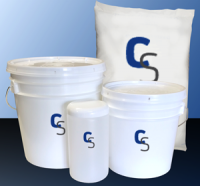Well, at the very least until the late 90's in Massachusetts, Calgon used to be sold in 3 formulas: "P" was full phosphates, "R" was "restricted" phosphates for areas where it was restricted, and "Z" was zeolites for areas where there was a phosphate ban.
Truth be told, I think at that point, MA areas (mostly by counties) were either "banned" or "restricted", but every once in a while one would find out a "P" formula at the supermarket, presumably because someone made a mistake in routing the pallets and someone else would compound the mistake by absent-mindedly putting the boxes on the shelves.
Either way, I used to buy a box or two of powdered Calgon every few months for stuff that needed special treatment (fabric dyeing, for example), it used to be cheap and easy to find anywhere. Then the powdered version disappeared about a couple of years ago (beginning of 2016, if I'm not mistaken) and only the liquid was available, which doesn't work as well for what I need it for. A brief search on the web doesn't seem to locate even a manufacturer for Calgon water softener anymore, unless you are in Europe.
That might explain the outrageous prices.
Meanwhile, I got a few pounds of Sodium Tripolyphosphate from the Chemistry Store in 2017 -- either I didn't order the right thing or they sent me the wrong thing. If I remember right, STPP is supposed to dissolve readily in warm or hot water, and this stuff turns into a hard to dissolve rock as soon as it touches water, even very hot water.
Cheers,
-- Paulo.



